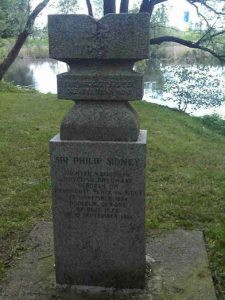
Sir Phillip Sidney (1554-1586)
Sir Phillip Sidney was born on November 30, 1554, in Kent, England. He was a knight, patron, poet, and soldier. He was known as to have all the traits of character and personality by Elizabethans, in which they’ve all admired. He was the eldest son of Sir Henry Sidney, lord deputy of Ireland for three times, and Lady Mary Dudley, the daughter of the Duke of Northumberland, and brother of Mary Sidney Herbert.
When young Sidney was ten, he attended the Shrewsbury School. While attending, he met his lifelong friend and biographer, Fulke Greville. Three years later, he transferred to the University of Oxford’s Christ Church College to continue his education. While attending, he learned about the politics of Europe and became familiar with many of Europe’s leading statesmen. He left school without taking a degree and completed his education by extended travels on the Continent. He met many kings, queens, philosophers, and poets while on his travels.
Sidney then joined the diplomatic service as an ambassador to King Charles IX of France. He provided diplomatic services in Europe for Queen Elizabeth, just like his father. In 1580, Sidney’s Protestant convictions led him publicly to disagree with Queen Elizabeth’s projected marriage to the Catholic Duke of Anjou. The Queen wasn’t too happy about the interference with her diplomatic maneuvers, so she dismissed Sidney from the court.
When Sidney retired, he wrote a long, epic romance called “Arcadia”. He wrote this in two forms in which they are known as “Old Arcadia” and “New Arcadia”. When “Old Arcadia” was finished (in five “books”), he began to expand it but it broke off in mid-sentence and was left unfinished. “New Arcadia” was almost three books. In 1593, his sister Mary made changes to the “New Arcadia” and the last two books of “Old Arcadia” and combined them together and published them as one big text. Both the original version and the revision are full of mistaken identify and tangled love situations, but the “New Arcadia” has more of a elevated tone of seriousness.
On October 17th, 1586, Sir Phillip Sidney was killed in battle at the age of thirty-two. His death led to him fighting for the Protestant side in the Battle of Zutphen. He composed a song and had it sung by his deathbed while all of England mourned.
 Sir Phillip Sidney’s grave
Sir Phillip Sidney’s grave
Fun facts
- He wrote one of the first sonnet sequences in English literature and literary criticism in English.
- Philip Sidney invented the name Pamela.
- Husband of Frances Walsingham.
Ringler, William Andrew. “Sir Philip Sidney.” Encyclopædia Britannica, Encyclopædia Britannica, inc., 21 Aug. 2017, www.britannica.com/biography/Philip-Sidney.
“Sir Philip Sidney.” Biography.com, A&E Networks Television, 17 Oct. 2017, www.biography.com/people/sir-philip-sidney-21397397.
Greenblatt, Stephen. “The Norton Anthology of English Literature.” The Norton Anthology of English Literature, Ninth ed., B, 2012, pp. 1037–1039.
“Five Fascinating Facts about Sir Philip Sidney.” Google, Google, www.google.com/amp/s/interestingliterature.com/2016/03/04/five-fascinating-facts-about-sir-philip-sidney/amp/.
